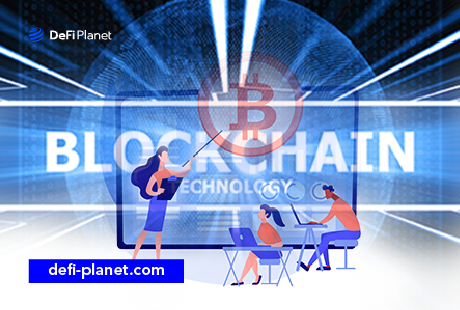Blockchain technology is becoming increasingly popular in the world today. It is being used extensively in many industries, most notably the finance sector, especially with decentralized finance.
According to the new International Data Corporation (IDC) guide, global spending on blockchain solutions is projected to grow from $6.6 billion in 2021 to nearly $19 billion in 2024. However, we are yet to see this growth spiral into the education sector, with only a handful of institutions adopting blockchain technology.
In this article, we will talk about how blockchain can be used in the education sector and its challenges.
Let’s dive in!
Blockchain In Education: An Overview
One industry where blockchain technology is beginning to make an impact is the education sector. According to the Gartner 2019 CIO survey, only 2% of higher education respondents said they had already deployed blockchain technology, whereas 18% reported that they were planning to do so within the next 24 months. This shows that the use of blockchain technology in the education sector is still in its infancy, and there is a long way to go till blockchain becomes mainstream. This is mainly because most institutions have taken a wait-and-see approach to use blockchain in education and hope to see the technology mature before adopting it.
Educational institutions should consider using blockchain because it offers the following benefits:
- Improved transparency – Blockchain is essentially a ledger that exists digitally and allows for open and transparent record-keeping of the events in real-time. It creates a chronological list of events that can be verified and used for record-keeping. In the educational sector, this feature of blockchain can be used to keep students honest about their progress by storing a report card on the blockchain that tracks all their work. This is bad news for students looking to make an excuse and tell their teachers that they ‘lost’ their homework as blockchain ensures that once something has been stored on it, it cannot be lost and verified by anyone as it is transparent.
- Engaging with smart contracts – The use of blockchain technology enables the application of smart contracts through which accountability can be created in the education system. For instance, instead of making tasks on google classroom, students and teachers can simply enter into a smart contract agreement with all the assignment specifications such as due date, grading deadline, etc. This contract will then execute automatically once the conditions get triggered. Moreover, smart contracts can also be used in the education sector to store student loan payment agreements, fees, etc.
- Enables incentivization of learning – Blockchain technology allows tokenization, enabling educational institutions to introduce the aspect of gamification to the education system. This can be highly beneficial as it motivates students to perform at their highest level. Moreover, it will also motivate students to adhere to deadlines. For instance, students can be awarded tokens to perform well in class or submit an assignment on time.
While there are many benefits of using blockchain in the education sector, there are also many challenges that come with it. Interestingly, most of these challenges are closely related to the blockchain trilemma that is currently also plaguing many cryptocurrency projects.
Let’s take a look at some of the challenges to using blockchain in technology.
- Security – While security is also one of the fundamental aspects of blockchain, unfortunately, it makes it vulnerable to attacks. This is because there is much sensitive information that is typically stored on the blockchain. For example, in the education sector, blockchains will store educational records and academic credentials. Because of this, educational institutions need to be assured that their data is safe.
- Compliance with the laws – Being a relatively new technology, the guidelines around the use of blockchain in the education sector are still not very clear. Thus, compliance with state and federal laws can be challenging as there is a lack of clear information. This can be especially challenging with laws and regulations related to data protection, as storing data on a blockchain is one of the most important use cases in education.
- Scalability – Scalability is another issue many blockchains face, including that of Ethereum, which tends to focus on decentralization and security rather than scalability. However, in the education sector, a lot of data is generated because of the vast number of students and alumni working in the space. As a result, the blockchain used in education needs to be highly scalable to avoid any network congestion that might slow down the speed of transactions occurring on the blockchain.
- Rate of adoption – According to the Gartner 2019 CIO survey, roughly half of the institutions were skeptical about implementing blockchain technology in their education system because of the nascent nature of the technology. As a result, since most institutions still do not completely understand and trust the technology, there is a lack of mainstream adoption in the education industry. However, as the technology matures, this is likely to change in the future.
- Cost – While the use of blockchain technology leads to savings in the long run, the initial infrastructure setup and implementation of blockchain can be quite costly, just like any other technology. Moreover, educational institutions will also need to go through a learning curve to understand how to make the most of blockchain technology. All this involves investing in the infrastructure and faculty of the educational institution.
Use Cases Of Blockchain In Education
Record Keeping
Record keeping is one of the best and most widely used applications of blockchain technology in education. This is because, in the education sector, there are virtually unlimited data points as there are so many students, and each student has hundreds of records that need to be stored. As a result, verification of everyone’s academic records and credentials can be time-consuming. This is where blockchain technology can streamline the verification process by eliminating most of the overheads associated with record keeping. Using blockchain technology, institutions can verify student records with a few simple clicks instead of going through piles of paper documentation that require case-by-case checking.
Student credentialing through blockchain:

Creating Improved Learning Platforms
Blockchain technology can be used to develop better online learning platforms. Such platforms could make the most of the benefits offered by blockchain in education, such as tokenization to incentivize students to learn and interact with the content on the platform. Moreover, as these platforms would be transparent since they are built on a blockchain, they will also allow students to track their progress. Additionally, through the application of smart contracts, assignments can also be automated.
A real-world example of using blockchain in education is Woolf University, which aims to create a borderless university powered by blockchain technology. Their university will use blockchain and smart contracts to run the operations. If achieved successfully, the benefits of such an educational platform will include:
- Lower tuition fees
- Increase in faculty remunerations
- Improved efficiency and cost-effectiveness
- Automation of administrative tasks
- Reduction in administrative overhead costs
- Creation of incentive models backed by the Woolf token or the university’s native currency
In Conclusion…
- Blockchain is an emerging technology, and its mainstream adoption in the educational sector will take time. This is because educational leaders, just like stakeholders in any organization or industry, are looking for blockchain technology to mature and want additional proof of its usability in the sector. However, once educational institutions better understand the benefits of using blockchain technology and how it can help them run their operations more efficiently, the adoption of blockchain in education will pick up the pace.
So, what do you think about using blockchain technology in the education sector? Do you think blockchain can improve the way education institutions function?
Comment below and let us know what you think!
If you would like to read more articles like this, follow DeFi Planet on Twitter and LinkedIn.





















